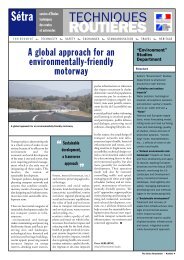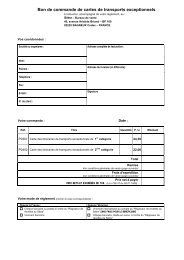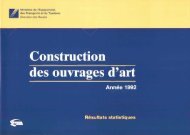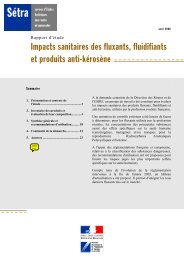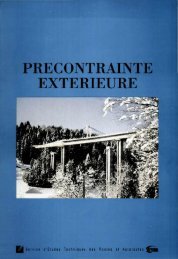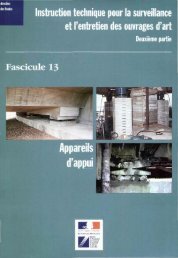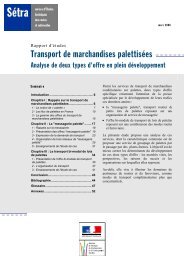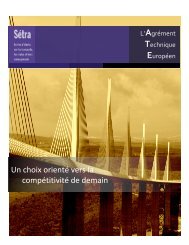Information note to raise awareness of existing structures ... - Sétra
Information note to raise awareness of existing structures ... - Sétra
Information note to raise awareness of existing structures ... - Sétra
Create successful ePaper yourself
Turn your PDF publications into a flip-book with our unique Google optimized e-Paper software.
=<strong>Information</strong> <strong>note</strong>^ìíÜçêëW=p¨íê~=J=i`m`==g~åì~êó=OMMU=<strong>Information</strong> <strong>note</strong> <strong>to</strong> <strong>raise</strong> <strong>awareness</strong> <strong>of</strong><strong>existing</strong> <strong>structures</strong> with externalprestressing protected by cement grout incontact with the tensile elements =`áîáä=båÖáåÉÉêáåÖ=píêìÅíìêÉë==OV=Several failures in external prestressing tendons protected by cement grout in contactwith the tensile elements have been recorded in France over the last few years. It shouldbe <strong>note</strong>d that since the publication <strong>of</strong> the circular n o 2001-16 <strong>of</strong> 28 February 2001, thistype <strong>of</strong> protection is in fact no longer used for external prestressing tendons.Structures potentially concerned are those <strong>of</strong> the period "early 1980s – beginning <strong>of</strong> the21 st century".The purpose <strong>of</strong> this <strong>note</strong> is <strong>to</strong> inform the various owners and construction managers <strong>of</strong>this phenomenon by outlining the state <strong>of</strong> present knowledge on the subject and bymaking recommendations concerning:• Investigations that can be carried out <strong>to</strong> assess the state <strong>of</strong> external prestressing.• Safety measures <strong>to</strong> be applied.• How <strong>to</strong> react in case <strong>of</strong> doubt over a tendon or in the event <strong>of</strong> a failed tendon..SummaryIntroduction ...................................................................................................................................2The state <strong>of</strong> present knowledge .....................................................................................................3Investigations <strong>to</strong> be performed......................................................................................................5Safety measures..............................................................................................................................6How <strong>to</strong> proceed in case <strong>of</strong> doubt over a tendon or when a failed tendon is discovered...............6Conclusions ....................................................................................................................................7Bibliography...................................................................................................................................7
<strong>Information</strong> Note <strong>of</strong> the Sétra – Civil Engineering Structures n° 29 2<strong>Information</strong> <strong>note</strong> <strong>to</strong> <strong>raise</strong> <strong>awareness</strong> <strong>of</strong> <strong>existing</strong> <strong>structures</strong> with external prestressing protected by cement grout in contact with the tensile elementsIntroductionExternal prestressing is a durable technique as illustratedby these two <strong>structures</strong> that were built in France in the1950s and are currently in excellent condition with theiroriginal tendons.Since the end <strong>of</strong> the 1970s, this technique has experiencedremarkable growth both in France and throughout theworld and is currently systematically used for large<strong>structures</strong> in prestressed concrete.However, several failures in external prestressing tendons,consisting <strong>of</strong> strands and protected by cement grout that isdirectly in contact with the tensile elements, have occurredin France over the last few years (5 cases reported).Two bridges from the 1950sThis phenomenon must be taken in<strong>to</strong> account in themoni<strong>to</strong>ring <strong>of</strong> <strong>structures</strong> that have this type <strong>of</strong> prestressingand also in ensuring the safety <strong>of</strong> staff that need <strong>to</strong> worknear the tendons.The purpose <strong>of</strong> this <strong>note</strong> is therefore <strong>to</strong> inform the variousclients and contrac<strong>to</strong>rs by outlining the state <strong>of</strong> presentknowledge on this subject and by makingrecommendations concerning:• Investigations that can be carried out <strong>to</strong> evaluate thestate <strong>of</strong> external prestressing.• Safety measures <strong>to</strong> be applied.• How <strong>to</strong> react in case <strong>of</strong> doubt over a tendon or inthe event <strong>of</strong> a failure.A failure in a tendon caused by corrosion
<strong>Information</strong> Note <strong>of</strong> the Sétra – Civil Engineering Structures n° 29 3<strong>Information</strong> <strong>note</strong> <strong>to</strong> <strong>raise</strong> <strong>awareness</strong> <strong>of</strong> <strong>existing</strong> <strong>structures</strong> with external prestressing protected by cement grout in contact with the tensile elementsThe state <strong>of</strong> present knowledgeThe various ways in which external tendons failFirst <strong>of</strong> all, the various ways in which external tendons fail need <strong>to</strong> be outlined. These are two case scenarios:Cases in which tensile elements are not in contact with the groutThis case concerns:• Tendons protected by a flexible product (grease, wax, etc.).• Galvanised tendons with or without a general duct.• Tendons whose strands are individually protected by HDPE ducts. These individual ducts may themselves beplaced in a general grouted ductIn this case, when a strand breaks, except if there is any severe friction<strong>of</strong> the devia<strong>to</strong>rs, the elastic energy amassed during the tensioning <strong>of</strong> thestrand is freed individually and the failure occurs without <strong>to</strong>o muchdamage.If there is a general duct, the strand can normally slide inside it, withoutwhipping and without modifying the state <strong>of</strong> stress in the other strands.If there is no general duct, whipping remains a possibility and collarsshould be fitted <strong>to</strong> avoid this happening.From a structural point <strong>of</strong> view, loss <strong>of</strong> efficiency is thereforeprogressive.A failure in strands not protected by groutCases in which tensile elements are in contact with the groutThese tendons are the subject <strong>of</strong> this information <strong>note</strong>.In this case, on the other hand, when a strand breaks, and because <strong>of</strong> thebond <strong>of</strong> the grout, the failed strand generally re-anchors itself inside thebundle <strong>of</strong> strands, the energy is not freed and the stress <strong>of</strong> the failedstrand is transferred <strong>to</strong> the other strands, thus increasing their stressaccordingly. If we consider that the tendons are tensioned at around70% <strong>of</strong> their breaking point, 6 strands need <strong>to</strong> be broken in a 19T15tendon, for example, for the breaking point <strong>to</strong> be reached in theremaining strands.The failure in this case is violent and it is a considerable amount <strong>of</strong>energy, equalling the <strong>to</strong>tality <strong>of</strong> the elastic energy amassed during thetensioning <strong>of</strong> the tendon that is suddenly freed.The tendon is dis<strong>to</strong>rted and can whip sideways. Material (grout,fragments <strong>of</strong> concrete or wedges may be projected and the ends can beexpelled. These occurrences may endanger persons nearby.In theory, there is no risk <strong>of</strong> whipping from short tendons (under 40metres long). The risk increases with the length <strong>of</strong> the tendons and inthe first span after the anchorage.From a structural point <strong>of</strong> view, when an external tendon breaks, itloses its efficiency along the entire length. On the other hand, forinternal tendons in concrete, due <strong>to</strong> the bond <strong>of</strong> the grout whencorrectly applied, the stress can re-anchor itself on a short length and afailure <strong>of</strong> strands, or even <strong>of</strong> a tendon, has only a local effect on thestrength <strong>of</strong> the structure.Dis<strong>to</strong>rtion <strong>of</strong> 19T15 tendons during dismantlingExpelling <strong>of</strong> the end <strong>of</strong> a 19T15 tendon duringdismantling
<strong>Information</strong> Note <strong>of</strong> the Sétra – Civil Engineering Structures n° 29 4<strong>Information</strong> <strong>note</strong> <strong>to</strong> <strong>raise</strong> <strong>awareness</strong> <strong>of</strong> <strong>existing</strong> <strong>structures</strong> with external prestressing protected by cement grout in contact with the tensile elementsGenerally speaking, the failure <strong>of</strong> one, or even two, external tendons is not likely <strong>to</strong> endanger the strength <strong>of</strong> the structure.Furthermore, experience shows that the probability <strong>of</strong> more than two tendons failing in a structure between two inspectionsis extremely low.The causes <strong>of</strong> recorded failuresRecorded failures are due <strong>to</strong> corrosion <strong>of</strong> tensile elements that are insufficiently protected because <strong>of</strong> duct grouting defects.These defects mainly result from instability <strong>of</strong> the grout during installation, possibly coupled with an inappropriate groutingprocedure.Generally speaking, these grouting defects result in defects in filling (partial or <strong>to</strong>tal voids, especially close <strong>to</strong> high pointsthat may be filled with water) and/or the presence on the upper part <strong>of</strong> the duct <strong>of</strong> a whitish product with the consistency <strong>of</strong>a damp, s<strong>of</strong>t paste <strong>to</strong>pped by a layer <strong>of</strong> water and a pocket <strong>of</strong> air. This water comes from the grout bleeding and hasremained trapped inside the watertight HDPE duct.Susceptibility <strong>of</strong> the tensile elements <strong>to</strong> stress corrosion cracking is an aggravating fac<strong>to</strong>r.A detailed explanation <strong>of</strong> this process, which mainly concerns post-1980 grout with high levels <strong>of</strong> admixture, is describedin the Sétra-LCPC information <strong>note</strong> n°21 <strong>of</strong> July 1996 [1]. To remedy this condition, the circular 99-54 <strong>of</strong> 20 August1999 [2] introduced a technical grouting report issued by the CIP, based on the highly discriminating test known as the"inclined tube test". This test was used by the EN 445 standard and a new, simpler test method on a 1m tube has just beenpublished by the LCPC (French Public Works Research Labora<strong>to</strong>ry), the labora<strong>to</strong>ry test method n°65 "Cement groutingstability test using an inclined tube <strong>of</strong> one metre".It should be <strong>note</strong>d that since the publication <strong>of</strong> the circular n o 2001-16 <strong>of</strong> 28 February 2001[3], this type <strong>of</strong> protection is infact no longer used for external prestressing tendons.Structures potentially concerned are therefore those <strong>of</strong> the period "early 1980s – beginning <strong>of</strong> the 21 st century".The conclusions <strong>of</strong> inquiries and investigationsSo as <strong>to</strong> better understand the phenomenon and its extent, an RST (French Scientific and Technical Network) think tankwas set up and a number <strong>of</strong> inquiries and investigations were carried out on approximately fifty <strong>structures</strong> <strong>of</strong> the nationalroads network.In particular, a systematic survey <strong>of</strong> ducts was carried out by hammer <strong>to</strong> detect any filling defects. At this point, thedifference needs <strong>to</strong> be made between cases <strong>of</strong> ducts that "sound hollow" only in the upper part – which generally simplymeans that the grout has come unstuck – and tendons that "sound hollow" on the entire perimeter, which means that there isa serious lack <strong>of</strong> grout.The main conclusions are as follows:• No new tendon or strand failure was recorded on this occasion.• Very roughly speaking, the proportion <strong>of</strong> external prestressing tendons that have failed is around 1/1000.• Even though a high proportion <strong>of</strong> <strong>structures</strong> have at least one area <strong>of</strong> the duct that "sounds hollow" in the upper partwhen hit with a hammer, only a small number <strong>of</strong> <strong>structures</strong>, around 10 %, have an area that "sounds hollow" on theentire perimeter <strong>of</strong> the duct.• The presence <strong>of</strong> areas that are incompletely or un-grouted does not systematically result in the corrosion <strong>of</strong> thetensile elements.• No admixture is suspected in particular.
<strong>Information</strong> Note <strong>of</strong> the Sétra – Civil Engineering Structures n° 29 5<strong>Information</strong> <strong>note</strong> <strong>to</strong> <strong>raise</strong> <strong>awareness</strong> <strong>of</strong> <strong>existing</strong> <strong>structures</strong> with external prestressing protected by cement grout in contact with the tensile elementsInvestigations <strong>to</strong> be performedTwo levels <strong>of</strong> investigations can be performed <strong>to</strong> assess the condition <strong>of</strong> prestressing in a structure:First levelAs regards <strong>structures</strong> in which there is no evidence <strong>of</strong> failed strands, it is recommended that an initial assessment <strong>of</strong> theexternal prestressing be carried out at the latest during the next Detailed Inspection.A special chapter <strong>of</strong> the Detailed Inspection report must be dedicated <strong>to</strong> external prestressing.This assessment shall comprise:• A preliminary collection <strong>of</strong> available information regarding the grouting procedures applied during construction:Post-tensioning system and tendon type, type <strong>of</strong> duct, composition <strong>of</strong> grout (type and source <strong>of</strong> cement, type <strong>of</strong> anyadmixture(s) used), grouting method used (cold or hot), order and dates <strong>of</strong> grouting <strong>of</strong> ducts, any grouting incidentsrecorded, statements from people who checked or participated in the grouting, etc.• A detailed visual inspection <strong>of</strong> the external prestressing including the following points:a) An inspection <strong>of</strong> the ducts taking care <strong>to</strong> record the presence <strong>of</strong> longitudinal cracks, faulty connections, anddis<strong>to</strong>rtion (ovalisation, helix-shaped excrescence that may suggest a failed strand), etc.All along the duct, the presence <strong>of</strong> traces <strong>of</strong> grout, plugs or holes in the HDPE duct should especially belooked for (these are signs <strong>of</strong> regrouting during construction and places where these signs can be seenrepresent potential faulty grouting areas).b) Observation <strong>of</strong> the external appearance <strong>of</strong> the anchor protection caps:– presence <strong>of</strong> rust stains on the surface <strong>of</strong> the caps and on the anchor plate– identification <strong>of</strong> the position <strong>of</strong> the grouting vents that should be located in the upper part <strong>of</strong> the cap– quality <strong>of</strong> filling the grouting vents– signs <strong>of</strong> the grout leaking on the outside <strong>of</strong> the cap– etc.• An examination <strong>of</strong> the ducts using a hammer. It is recommended that the ducts are surveyed along their entirelength (except at concrete crossing points) so as <strong>to</strong> detect if they "sound hollow". Attention is drawn <strong>to</strong> the fact thatsome HDPE, manufactured a long time ago, may harden and appear <strong>to</strong> "sound hollow".This initial assessment will give an overall vision <strong>of</strong> the quality <strong>of</strong> the tendon protection and the condition <strong>of</strong> theprestressing. However, areas with whitish paste cannot be detected and the areas <strong>of</strong> the ducts in the upper part <strong>of</strong> thecrossbeams on piers or at the anchoring points cannot be surveyed with a hammer.It should be <strong>note</strong>d that these investigations particularly need <strong>to</strong> be carried out on <strong>structures</strong> already inspected, but wherecertain parts were inaccessible during the first inspection (tendons near elevated segments on piers for example), specificmeans <strong>of</strong> access (scaffolding or platforms) may be needed.Second levelIf there is the slightest doubt over the condition <strong>of</strong> the prestressing after this initial assessment (presence <strong>of</strong> an area that"sounds hollow" along the entire length <strong>of</strong> a tendon, traces <strong>of</strong> damp or corrosion, etc.) or if the administra<strong>to</strong>r wishes <strong>to</strong>improve their knowledge <strong>of</strong> the state <strong>of</strong> their structure, more advanced investigations should be performed, including:• The use <strong>of</strong> a capacitive sensor developed by the French Regional Public Works Research Labora<strong>to</strong>ry at Autun andby the LCPC that enables the detection <strong>of</strong> voids in ducts without having <strong>to</strong> open them.The opening <strong>of</strong> windows in the duct without damaging the tensile elements and, if necessary, the removal <strong>of</strong>samples for analysis (water, whitish paste, results <strong>of</strong> corrosion, etc.). These openings <strong>of</strong> around 10 x 25cm are <strong>to</strong> bemade in the areas deemed suspect during the initial assessment. Attention is drawn <strong>to</strong> the need <strong>to</strong> reclose the ductsperfectly after taking the samples.
<strong>Information</strong> Note <strong>of</strong> the Sétra – Civil Engineering Structures n° 29 6<strong>Information</strong> <strong>note</strong> <strong>to</strong> <strong>raise</strong> <strong>awareness</strong> <strong>of</strong> <strong>existing</strong> <strong>structures</strong> with external prestressing protected by cement grout in contact with the tensile elements• The dismantling <strong>of</strong> the caps, if the operation can be performed quickly without placing excessive stress on thetendons.• Endoscopic observation in the ducts, particularly at the high points, close <strong>to</strong> crossbeams, if this is possible.• Gammagraphies.• Any other means that allows information <strong>to</strong> be gained as regards the content <strong>of</strong> the ducts (infrared thermography,etc).Safety measuresA risk study has been carried out on a structure with a failed tendon (the Saint-Cloud viaduct that links the Paris ring road<strong>to</strong> the A13 mo<strong>to</strong>rway) by a specialised independent consultancy agency. In this case, the study concluded that even thoughthe risks incurred by employees carrying out repair operations on the failed tendon were acceptable in comparison with thelevel <strong>of</strong> risk in the pr<strong>of</strong>essions in question, this risk was significant and should be minimised. Further information regardingthis repair is provided in a Sétra Civil Engineering Structures bulletin. The risk is significantly lower for the inspections andinvestigations outlined above that do not require a prolonged visit <strong>to</strong> the structure. Nevertheless, precautions should also betaken <strong>to</strong> minimise risks during these visits. These mainly involve simple common-sense measures that are moreoverapplicable <strong>to</strong> all types <strong>of</strong> visits inside the structure.Below several general measures are listed <strong>to</strong> assist in the development prior <strong>to</strong> inspections <strong>of</strong> a specific summaryintervention procedure and which could be adapted and added <strong>to</strong> according <strong>to</strong> the each structure.General measures:• In the event <strong>of</strong> failure, a tendon can whip violently. It is therefore advisable not <strong>to</strong> remain needlessly in thestructure.• If a failure occurs, the anchor may recede several metres or if the anchor does not recede, the tendon may sufferfrom substantial lateral dis<strong>to</strong>rtion near the anchorage. Care must be taken therefore not <strong>to</strong> stand behind the anchorsin the axis <strong>of</strong> the tendon and upstream from the anchor near the tendon in the surrounding area.• Acoustic emission measurements carried out on a structure that had experienced a failed tendon have shown thatfailures in the wires that comprise the strands appear <strong>to</strong> occur for the most part when temperatures are low. It istherefore advisable <strong>to</strong> avoid visiting the structure if the external temperature fell below 0° C the week preceding thevisit.• If external signs cast doubts over the condition <strong>of</strong> the prestressing (traces <strong>of</strong> corrosion on the anchors or a bulge inthe ducts, etc.) or if a tendon failure has been observed, surveys with a hammer and second level inspections shouldnot be performed without prior consideration <strong>of</strong> risk management.How <strong>to</strong> proceed in case <strong>of</strong> doubt over a tendon or when a failedtendon is discoveredAside from the safety measures outlined in the preceding paragraph, it is not possible <strong>to</strong> issue general rules as regards how<strong>to</strong> proceed when a structure has a suspect or failed tendon.Each structure has <strong>to</strong> be studied individually. Experts need <strong>to</strong> be consulted, such as those from Scientific and TechnicalNetwork (RST) <strong>of</strong> French Public Works Department <strong>of</strong>fices (Sétra, LCPC, Public Works technical research centres).Depending on the seriousness <strong>of</strong> the case in hand, various options may be envisaged, including:• Closer moni<strong>to</strong>ring <strong>of</strong> the tendons.• Close supervision with acoustic moni<strong>to</strong>ring. This moni<strong>to</strong>ring enables the detection <strong>of</strong> failure in the wirescomprising the strands and highlights any acceleration in the situation.• The fitting <strong>of</strong> energy absorbers. These have already been tested in the above-mentioned Saint-Cloud viaduct andenable whipping <strong>to</strong> be avoided (although the risk <strong>of</strong> the anchor receding remains, as does limited buckling in thefirst span after the anchorage) and allow dismantling operations <strong>to</strong> be performed more smoothly.
<strong>Information</strong> Note <strong>of</strong> the Sétra – Civil Engineering Structures n° 29 7<strong>Information</strong> <strong>note</strong> <strong>to</strong> <strong>raise</strong> <strong>awareness</strong> <strong>of</strong> <strong>existing</strong> <strong>structures</strong> with external prestressing protected by cement grout in contact with the tensile elements• Local regrouting. Wide-reaching investigations recently carried out on several <strong>structures</strong> <strong>of</strong> the national roadnetwork have shown that the absence <strong>of</strong> grouting in a duct was not systematically synonymous with disorder in thetensile elements.• Drying the ducts <strong>to</strong> s<strong>to</strong>p corrosion by blowing in dehumidified air. This technique, which is used on the majortendons <strong>of</strong> suspended bridges, has not yet been subjected <strong>to</strong> operational application on external prestressed tendons.• The replacement <strong>of</strong> all or part <strong>of</strong> the prestressing. The Sétra guide published in February 1990 "Précontrainteextérieure (External prestressing)" [4], provides information about dismantling methods. Experience <strong>of</strong> recordedfailures and dismantling carried out reveal that damage <strong>to</strong> the structure generally remains very limited (superficialsplintering <strong>of</strong> the concrete).It should however be pointed out that, at the time <strong>of</strong> writing, in the case <strong>of</strong> the few <strong>structures</strong> that have experienced tendonfailure <strong>of</strong> this type, in every case the decision has finally been taken <strong>to</strong> replace the entire prestressing.ConclusionsThe condition <strong>of</strong> external prestressed <strong>structures</strong> protected by cement grout in contact with the tensile elements can beassessed and moni<strong>to</strong>red satisfac<strong>to</strong>rily, following the recommendations provided above.Even though technical progress made over the past years has lead <strong>to</strong> a considerable improvement and although the risk <strong>of</strong>failure remains very low according <strong>to</strong> the present state <strong>of</strong> our knowledge, we recommend that diagnoses are carried out andthat any necessary repairs are made.Furthermore, the attention <strong>of</strong> administra<strong>to</strong>rs is drawn <strong>to</strong> the careful moni<strong>to</strong>ring and maintenance required <strong>of</strong> all externaltendons, including those with other types <strong>of</strong> protection.Other defects resulting from insufficient maintenance that are susceptible <strong>to</strong> affect the durability <strong>of</strong> tendons also need <strong>to</strong> bedealt with rapidly (such as an interruption in ducts, exposed strands, damage <strong>to</strong> anti-vibration devices, etc.).Example <strong>of</strong> a defect that requires rapid repairBibliography[1] Coulis pour injection de conduits de précontrainte - Note d'information, Série Ouvrages d’art, n° 21 - Sétra/LCPCjuillet 1996 - <strong>Information</strong> <strong>note</strong>, Civil Engineering Structures (Série Ouvrages d’art) n° 21 - Sétra/LCPC July 1996.[2] Circulaire n° 99-54 du 20 août 1999 instituant un avis technique des coulis d´injection pour conduits de précontrainte,délivré par la commission interministérielle de la précontrainte - Circular n° 99-54 <strong>of</strong> 20 August 1999 instituting atechnical grouting report for prestressing ducts, issued by the interdepartmental prestressing commission.[3] Circulaire n° 2001-16 du 28 février 2001 relative à la conception de la précontrainte extérieure au bé<strong>to</strong>n - Circular n°2001-16 <strong>of</strong> 28 February 2001 regarding the conception external concrete prestressing.[4] Précontrainte extérieure – Guide technique – Sétra, février 1990 – référence : F9024 - Technical guide – Sétra,February 1990 – reference: F9024
Technical writersThierry KRETZ – Sétra / CTOAtéléphone : 33 (0)1 46 11 32 58 – télécopie : 33 (0)1 46 11 83 58mél : thierry.kretz@developpement-durable.gouv.frJean-Michel LACOMBE – Sétra / CTOAtéléphone : 33 (0)1 46 11 32 67 – télécopie : 33 (0)1 46 11 83 67mél : jean-michel.lacombe@developpement-durable.gouv.frBruno GODART - LCPCtéléphone : 33 (0)1 40 43 53 32 – télécopie : 33 (0)1 40 43 65 20mél : bruno.godart@lcpc.gouv.frTechnical informationsCentres d'études techniques de l'Équipement (CETE)NOTESétra’s information notice collection is onlyintended for the purpose <strong>of</strong> makinginformation rapidly available, which meansthat information may not be exhaustive orit may contain errors. Neither the writer northe administrative department may be heldliable for any such errors.The companies named in thesedocuments are for example only, asthey are deemed necessary for thecomprehension <strong>of</strong> the text as well asfor its implementation.This document is available and can be downloaded on Sétra website:http://www.setra.equipement.gouv.frResponsible publisher: Jean-Claude Pauc –Managing Direc<strong>to</strong>r, SétraThe Sétra authorization is required for reproduction <strong>of</strong> this document (all oreven part).Référence : 0839A – ISSN : 1250-8675The Sétra belongs<strong>to</strong> the Scientific andTechnical Network (RST)<strong>of</strong> the French PublicWork Ministry



